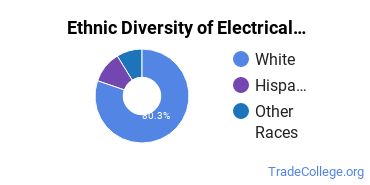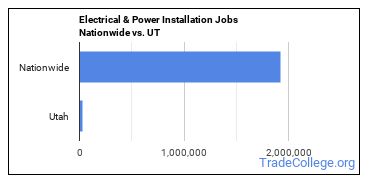Electrical & Power Installation Schools in Utah
In 2021-2022, 241 students earned their Electrical Transmission Installation degrees in UT.
An Electrical & Power Installation major is the 13th most popular major in this state.
Featured schools near , edit
Education Levels of Electrical & Power Installation Majors in Utah
Electrical Transmission Installation majors in the state tend to have the following degree levels:
| Education Level | Number of Grads |
|---|---|
| Award Taking Less Than 1 Year | 227 |
| Associate Degree | 10 |
| Award Taking 1 to 2 Years | 4 |
| Award Taking 2 to 4 Years | 4 |
Gender Distribution
In Utah, a electrical transmission installation major is more popular with men than with women.

Racial Distribution
The racial distribution of electrical transmission installation majors in Utah is as follows:
- Asian: 0.4%
- Black or African American: 0.4%
- Hispanic or Latino: 14.5%
- White: 79.7%
- Non-Resident Alien: 0.0%
- Other Races: 5.0%

Jobs for Electrical & Power Installation Grads in Utah
In this state, there are 25,020 people employed in jobs related to an electrical transmission installation degree, compared to 1,919,300 nationwide.

Wages for Electrical & Power Installation Jobs in Utah
In this state, electrical transmission installation grads earn an average of $62,890. Nationwide, they make an average of $67,800.

Most Popular Electrical & Power Installation Programs in UT
There are 7 colleges in Utah that offer electrical transmission installation degrees. Learn about the most popular 7 below:
Roughly six years after entering college, graduates of this school earn $30,112 a year. Of all the students who attend this school, 41% get financial aid. The student to faculty ratio is 11 to 1.
Of all the students who attend this school, 63% get financial aid. Graduates earn an average $31,031 after graduation. Students enjoy a student to faculty ratio of 14 to 1.
In their early career, Dixie Tech grads earn an average salary of $29,735. 66% of students get financical aid. The student to faculty ratio is 7 to 1.
10 to 1 is the student to faculty ratio. Grads earn an average early-career salary of $36,469 after earning their degree at this institution. Of all the students who attend this school, 38% get financial aid.
This public school has an average net price of $6,919. The student loan default rate of 3.30% is a good sign that graduates can afford their loan payments. Students enjoy a student to faculty ratio of 17 to 1.
This public school has an average net price of $7,845. In their early career, Bridgerland ATC grads earn an average salary of $36,093. The student to faculty ratio is 16 to 1.
This public school has an average net price of $13,233. Most students complete their degree in 4.66 years. The student to faculty ratio is 21 to 1.
Electrical & Power Installation Careers in UT
Some of the careers electrical transmission installation majors go into include:
| Job Title | UT Job Growth | UT Median Salary |
|---|---|---|
| Security and Fire Alarm Systems Installers | 44% | $48,350 |
| Construction Trades and Extraction Worker Supervisors | 41% | $59,250 |
| Electricians | 35% | $55,440 |
| Mechanic, and Repairer Supervisors | 26% | $63,580 |
| Signal and Track Switch Repairers | 19% | $0 |
| Electrical Power-Line Installers and Repairers | 18% | $81,770 |
Related Majors in Utah
Below are some popular majors in the state that are similar to electrical transmission installation.
| Major | Annual Graduates in UT |
|---|---|
| Plumbing & Water Supply | 145 |
| Carpentry | 128 |
| Building Management & Inspection | 108 |
| Construction | 1 |
View all majors related to Electrical & Power Installation
Explore Major by State
Alabama
Arkansas
Connecticut
Florida
Idaho
Iowa
Louisiana
Massachusetts
Mississippi
Nebraska
New Jersey
North Carolina
Oklahoma
Rhode Island
Tennessee
Vermont
West Virginia
View Nationwide Electrical & Power Installation Report
References
- College Factual
- National Center for Education Statistics
- O*NET Online
- Image Credit: By Fran Hogan under License
More about our data sources and methodologies.
Featured Schools
 Request Info
Request Info
|
Southern New Hampshire University You have goals. Southern New Hampshire University can help you get there. Whether you need a bachelor's degree to get into a career or want a master's degree to move up in your current career, SNHU has an online program for you. Find your degree from over 200 online programs. Learn More > |

